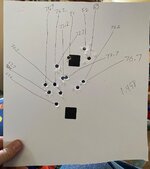Radosilver
Lil-Rokslider
I have a question on optimal charge weight. Based on the info below, would you abandon this powder and move on to another powder for load development, or is there something I am missing that maybe would make it worth sticking with testing?
This if my first attempt at testing like this, so if I'm overlooking something obvious my apologies. But, I shot 10 singles at 100 yards out of my .300 Win yesterday in an attempt to locate a group of 3 or so shots close to each other that would give me a starting point for trying to find the optimal charge weight for my rifle with IMR-7828SSC. I posted a pic below. The 3 fouling shots are marked F1. The others are marked with the charge weight. The charge weight spread was from 69.2 gr to 73.7 gr. As you can see from the pic, there doesn't appear to be a range of powder charge with the impacts close to each other. The muzzle velocity also seemed to jump around a lot too rather than a steady increase as the charge weight went up. Maybe that's normal. The bullet is a ELD-X 212 grain if that factors in. Thanks.
This if my first attempt at testing like this, so if I'm overlooking something obvious my apologies. But, I shot 10 singles at 100 yards out of my .300 Win yesterday in an attempt to locate a group of 3 or so shots close to each other that would give me a starting point for trying to find the optimal charge weight for my rifle with IMR-7828SSC. I posted a pic below. The 3 fouling shots are marked F1. The others are marked with the charge weight. The charge weight spread was from 69.2 gr to 73.7 gr. As you can see from the pic, there doesn't appear to be a range of powder charge with the impacts close to each other. The muzzle velocity also seemed to jump around a lot too rather than a steady increase as the charge weight went up. Maybe that's normal. The bullet is a ELD-X 212 grain if that factors in. Thanks.

